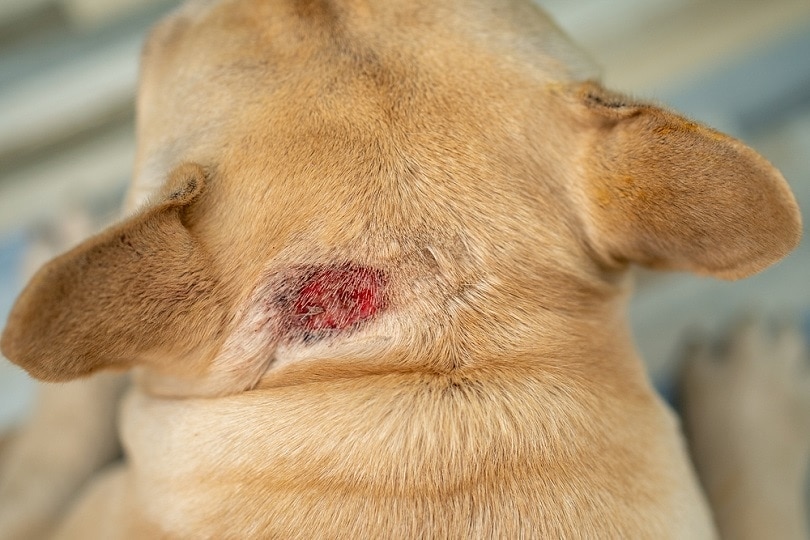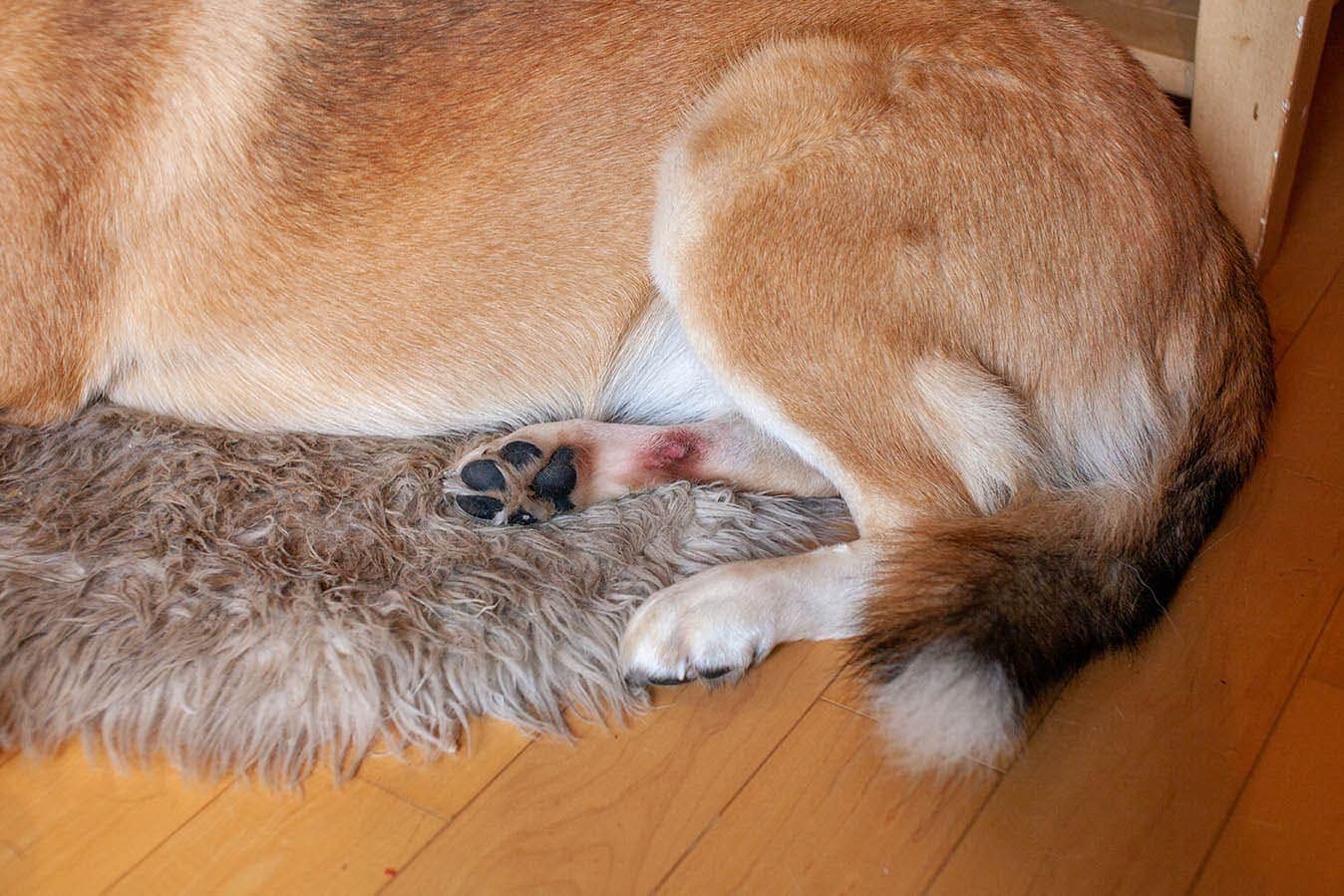Hot spots are a common canine condition. Many dogs will experience hot spots, which means many owners will have to find a cure. While you can obviously take your dog to the vet and get treatment, many owners prefer to find natural and less expensive solutions to common canine health concerns.
For these owners, coconut oil seems like a sensible substitution. But can this type of oil really treat your dog’s hot spots, and is it the best course of action for such an issue? The short answer: it depends. Let’s take a closer look and determine whether coconut oil is a good choice for curing your dog’s hot spots.
What’s a Hot Spot?
Before you can treat a hot spot, you have to know what it is. Hot spots are a skin infection. Generally, they start as just a patch of itchy skin. Soon, with the help of excess moisture, the condition worsens and spreads. Before long, what started as a little itchy spot is now a big red lump that’s possibly oozing puss. Once it reaches this stage, hot spots look awful, and they feel just as bad for your dog.

Often, these hot spots are mostly self-inflicted. When the skin starts itching, your dog will bite, chew, scratch, and lick the affected area. But if the skin opens up or gets damaged, it opens the door for bacteria to come inside. As the area remains moist, it becomes a breeding ground for these bacteria, worsening and spreading the condition.
You’ll notice that your dog is clearly in discomfort. If you attempt to touch the hot spot, your dog will wince and make it clear that they’re in pain. But you’ll probably find that your dog is unable to stop touching and licking the area, which is going to continue making it worse.
Causes of Hot Spots in Dogs
Now we know how hot spots form, but what are some common underlying causes of them? All it takes is for your dog to become itchy. Once that happens, your canine might continue the process of creating a hot spot on its own, without even realizing it.
The following are all ways that hot spots can get started:
- Wounds
- Flea bites
- Mites
- Allergies
- Painful conditions like hip dysplasia, arthritis, or anal sac disease
- Mental distress
- Contact dermatitis
- Other insect bites or parasites
If you see signs of any of these on your dog, you’ll want to take action to avoid hot spots. Unfortunately, hot spots are often the first sign of an underlying issue, which means you can’t always identify the issue until the hot spot becomes a bright red arrow pointing directly to it.

Is Treating Hot Spots with Coconut Oil Safe?
Many people prefer natural alternatives to prescribed medications, for themselves as well as their pets. If you’re one of these people, then you likely use coconut oil as a remedy for your own health concerns when applicable. If it’s safe for you, it should be safe for your dog too, right? After all, coconut oil is natural.
Luckily, yes, coconut oil is generally considered safe for dogs. When treating a hot spot, you would generally only apply the coconut oil topically, but even if your dog ingests it, coconut oil is safe for them. In large enough quantities it can cause pancreatitis though, so you don’t want to overdo it. That said, some people even give their canines coconut oil orally to aid with digestion, so a moderate amount ingested should pose no harm.
Is Coconut Oil Effective for Treating Hot Spots?
We know that coconut oil is mostly harmless for your dog, but is it effective at treating hot spots? It doesn’t make much sense to spend time on cures that don’t work. The truth is, some people have seen positive results when treating their dog’s hot spots with coconut oil. However, this method isn’t successful all the time.
For treating hot spots, most pet owners will apply coconut oil topically to the affected area. This could take a few applications spread out over several days. Within that time frame, shrinking of the hot spot should be observed. Because the coconut oil is covering the hot spots, it could provide relief for your dog’s itching and discomfort. Moreover, it could prevent your dog from licking and scratching, which will help the area heal.

Potential Downsides of Using Coconut Oil to Treat Hot Spots
The problem with topically treating hot spots using coconut oil is that it will keep the affected area moist. Most treatments for hot spots do the opposite, drying out the hot spot to prevent bacteria from colonizing. When the area is left moist under coconut oil, the bacteria may not die off.
Worse, coconut oil might only kill off some of the bacteria, not all. While it has been shown to have some antibacterial properties, coconut oil isn’t a broad-spectrum anti-bacterial. It will only kill off some strains, which means it could kill your dog’s beneficial bacteria and leave behind the detrimental bacteria that are worsening the infection. In such a case, the coconut oil could be preventing your dog’s body from healing.
Other Dog Hot Spot Treatment Options
If your dog has hot spots, it’s recommended that you immediately schedule a visit to the vet. Your vet can help determine what the underlying cause is of your dog’s hot spots, enabling a proper treatment. This is usually done using antibiotics and anti-inflammatories. Depending on the underlying issue, additional treatment can range from flea medication to treatment for a variety of diseases that could be causing your dog to lick excessively and create the hot spots.

How to Prevent Hot Spots on Your Dog
Naturally, the best way to cure hot spots on your dog is to prevent them from occurring in the first place. While you can’t completely prevent such conditions, you can minimize the likelihood of them by taking some smart precautions.
- Regularly brush your dog’s coat and keep them properly groomed. Tangled and matted fur can irritate your dog’s skin and trap bacteria, causing your dog to scratch and lick.
- Bath your dog on a regular schedule and keep their coat clean.
- Always dry your dog thoroughly after they get wet. This is most important in the warmer months when hot spots are commonplace.
- Treat your dog against fleas, ticks, and other common parasites.
- If your dog suffers from painful conditions, address the underlying problems.
- Cure any skin conditions that appear immediately.
- Prevent stress and boredom that can lead to licking and scratching by ensuring your dog is well stimulated and gets plenty of exercise.
Conclusion
Hot spots are a very common occurrence in canines, especially in the summer when the heat helps to breed bacteria. While there are some preventative measures you can take against hot spots, you can never eliminate the threat completely. Luckily, curing hot spots is relatively easy. While coconut oil might cure this condition for some dogs, it’s not a guarantee. In fact, the coconut oil could possibly make your dog’s hot spots worse. If you plan to go this route, make sure you keep a close eye on your dog’s condition and head to the vet if it doesn’t start receding after a few short days of attempted treatment.
Featured Image Credit: Ashley-Belle Burns, Shutterstock








